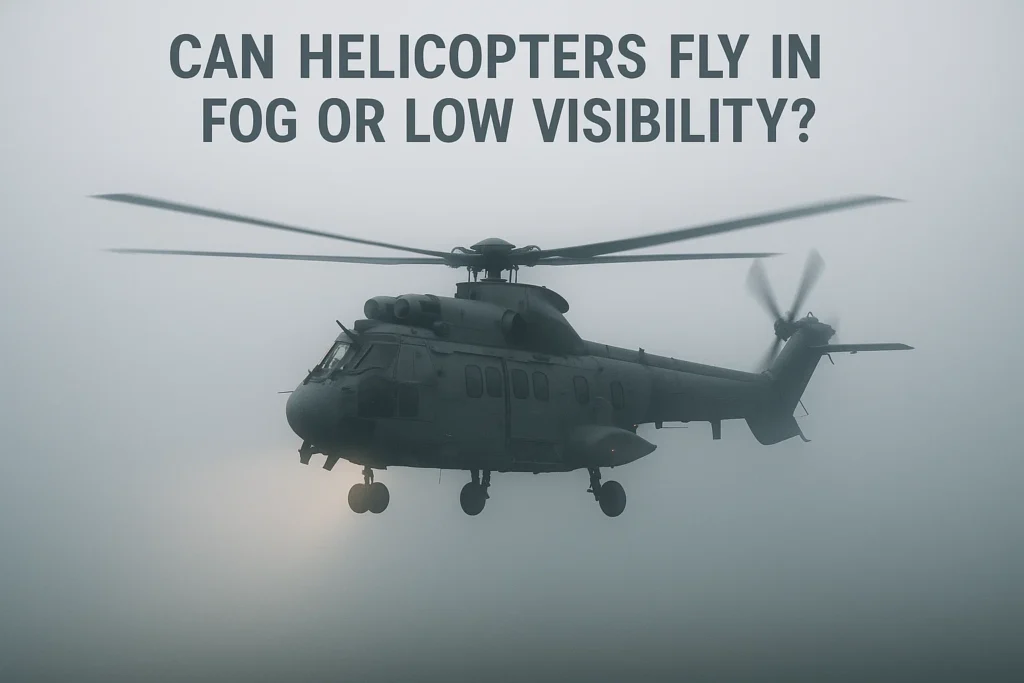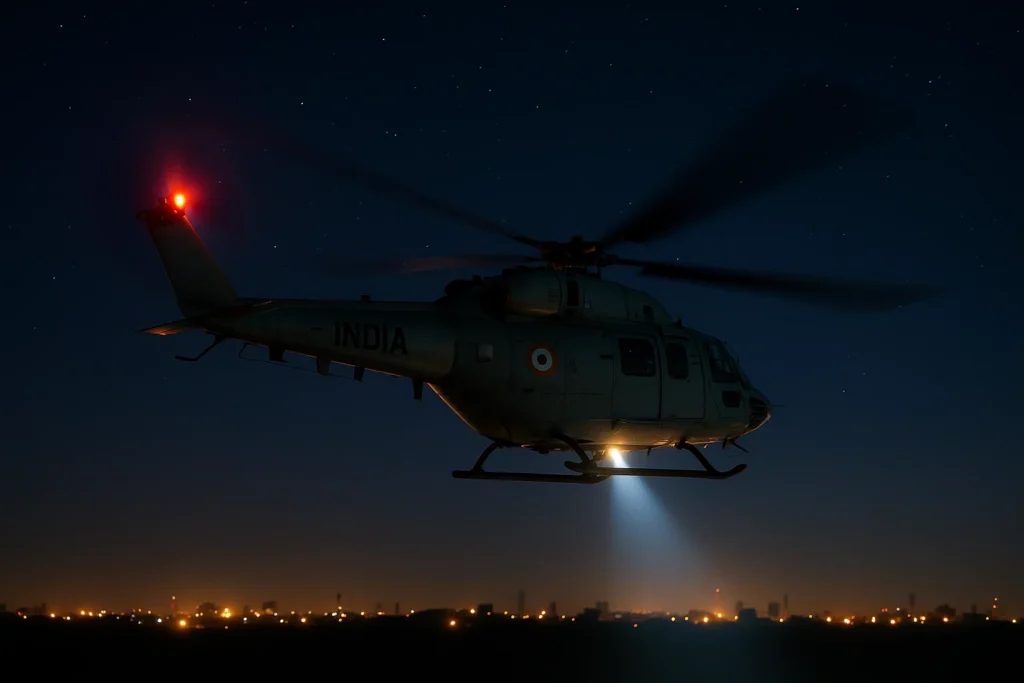✨ Introduction: Can Helicopters Fly in Fog or Low Visibility?
Helicopter flights are generally known for their flexibility and versatility, offering access to destinations that are often unreachable by other modes of transport. But when fog or low visibility conditions arise, can helicopters still fly safely?
The answer is yes, but with significant limitations and precautions. Pilots must adhere to strict regulations and take special safety measures when flying in such conditions. In this blog post, we’ll explore how helicopters manage fog and low visibility, the risks involved, and the necessary safety protocols.
🌍 Can Helicopters Operate in Fog or Low Visibility?
🚁 Instrument Flight Rules (IFR)
Helicopters are capable of flying in fog or low visibility, but only under certain conditions. The Instrument Flight Rules (IFR) apply when the pilot is unable to rely on visual references to navigate. In these cases, the pilot uses instruments to control the helicopter.
-
IFR Operations: Helicopters operating in low visibility must be equipped with the necessary instrumentation to comply with IFR. Pilots must also be trained and certified to fly under these conditions.
-
Helicopter Type: Not all helicopters are capable of flying under IFR conditions. They must have certified equipment, including GPS, autopilot, and flight instruments to assist with navigation during low-visibility conditions.
⚖️ Visual Flight Rules (VFR)
For helicopters flying under Visual Flight Rules (VFR), which are often the case for private or recreational flights, visibility must be sufficient for the pilot to see and avoid obstacles.
-
VFR Restrictions: In fog or low visibility, flying under VFR is typically not allowed. Pilots must switch to IFR or postpone the flight to avoid the risks associated with poor visibility.
🌍 Risks of Flying in Fog or Low Visibility
Flying in fog or low visibility presents several risks, primarily related to spatial disorientation and the difficulty of avoiding obstacles.
🚨 1. Spatial Disorientation
-
In fog or low visibility, pilots may struggle to maintain proper orientation. Without visual references, they may become disoriented, leading to dangerous situations such as the graveyard spiral or controlled flight into terrain (CFIT).
🚁 2. Obstacles and Terrain
-
When flying in fog, pilots face the challenge of avoiding obstacles, such as mountains, buildings, or power lines, especially when flying at low altitudes. This is particularly concerning for helicopters, which often fly in confined or remote areas where terrain awareness is critical.
⚠️ 3. Loss of Situational Awareness
-
Even experienced pilots can face challenges maintaining situational awareness in low-visibility conditions. This can result in incorrect decisions and unsafe flight paths.
🌍 Regulations and Safety Measures for Flying in Low Visibility
🛑 Safety Protocols for IFR Helicopter Flights
To mitigate the risks associated with low visibility, helicopters that fly in fog or poor visibility must meet certain requirements:
-
Helicopter Certification: Helicopters must be certified for IFR flight, meaning they are equipped with autopilot systems, navigation instruments, and backup systems that allow the pilot to navigate without visual reference.
-
Pilot Training: Pilots must undergo specialized training to fly in low-visibility conditions and be certified for IFR operations.
🚁 Pre-Flight Considerations
-
Weather Assessment: Before flying in fog or low visibility, pilots assess the weather conditions carefully. Weather forecasts and visibility reports help them determine whether flying is safe.
-
Instrument Proficiency: Helicopter pilots flying under IFR conditions must be proficient in reading instruments, understanding altimeter readings, and maintaining a clear understanding of the helicopter’s altitude and heading.
🛡️ Onboard Equipment
-
Navigation Systems: Helicopters flying in low visibility rely on advanced navigation systems such as GPS, radar, and flight management systems to keep the aircraft on course.
-
Autopilot: Many helicopters are equipped with autopilot systems to assist the pilot in maintaining the proper course and altitude during low-visibility conditions.
🌍 What Happens If Conditions Are Too Hazardous for Flight?
When visibility drops below acceptable limits or when the weather conditions are considered unsafe, pilots must prioritize safety and choose alternative options:
-
Flight Diversion: Pilots may opt to divert the flight path to clearer areas or to land at an alternate location where visibility is better.
-
Flight Cancellation or Delay: In cases of severe weather, flights may be cancelled or postponed until conditions improve. Safety is always the primary concern, and canceling flights is common when the visibility is too poor.
-
Emergency Landing: In rare cases, pilots may have to make an emergency landing if they cannot proceed safely. Helicopters are equipped with emergency landing procedures and safety systems to handle such situations.
🌍 How Helicopters Handle Low Visibility in Fog: Key Takeaways
-
IFR Training: Pilots must be trained and certified to fly under Instrument Flight Rules (IFR) in fog and low visibility.
-
Helicopter Equipment: The helicopter must be properly equipped with instruments that support IFR operations, including navigation aids and backup systems.
-
Weather Considerations: Pilots need to carefully assess the weather and visibility before flying in such conditions to avoid risks like spatial disorientation and obstacle collisions.
-
Flight Delays: Flight cancellations or delays are common in poor visibility conditions to ensure safety.
🌍 Conclusion: Can Helicopters Safely Fly in Fog or Low Visibility?
While helicopters can fly in fog or low visibility, it requires specialized training, proper equipment, and a commitment to safety. Flying in these conditions is more dangerous than typical flying, so it’s essential for pilots to rely on instruments and follow established protocols to ensure a safe journey. Helicopter services in fog or low-visibility conditions are typically restricted and carefully regulated to ensure passenger safety.
At DreamSafar, we prioritize safety and reliability in all our helicopter services. Our fleet is equipped with the latest navigation instruments and our pilots are highly trained to operate safely under various weather conditions.
🔗 Useful Links:
Resources:
❓ FAQ Section:
Q1: Can helicopters fly in dense fog?
A1: Yes, helicopters can fly in dense fog, but only if they are equipped with IFR systems and the pilot is trained for instrument flight.
Q2: Are helicopters allowed to fly in low visibility conditions?
A2: Helicopters can fly in low visibility conditions under IFR if the pilot has the proper training and the helicopter meets the necessary equipment requirements.
Q3: What happens if the helicopter cannot fly due to weather?
A3: If the weather conditions are too severe, the flight will either be delayed, diverted, or cancelled to ensure the safety of all passengers.


